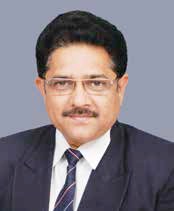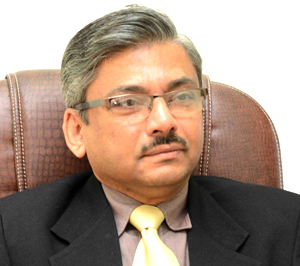

Zoya Brar,
Managing Director and Co-Founder,
CORE Diagnostics

Combining her vision with tenacity and skill to realize her dreams, Zoya Brar, Managing Director & Co-Founder, has forayed into diagnostics and has demonstrated her ability to streer CORE’s meteoric rise. In conversation with Shahid Akhter, ENN she shares her views, vision and the journey so far.
With your background in sociology, how did you end up bonding with pathology?
My dormant DNA of entrepreneurship finally expressed itself, and restlessness set in. While I was having fun at Google, I felt I was adding value, but not creating. At that point, doing a start-up was only a matter of time. The question was not if, but what (the when would simply follow). Serendipity played an important part in diagnostics ending up as my calling. What started out as just another social dinner with a family friend from the Silicon Valley went on late into the wee hours of the morning. One thing led to the other and it culminated in path lab idea.
With so many path labs already there, why did you think of another lab?
While there are many path labs, there is not a single lab in India that is focussed on Esoteric testing. Diagnostics makes up for only 3% of the Healthcare expense, but impacts 70% of the cost downstream, and 100% of the outcome. So, while high end testing might sound like a cost burden, it is exactly the opposite. It improves the clinical outcome, and might in fact, reduce the downstream cost of treatment. Seeing such a clear white space, or a gap in the Healthcare Delivery chain, my start-up was right there, staring at me. It was time to build a lab whose Raison dªtre was high-end esoteric testing “ based on molecular diagnostics, genomics, proteomics, etc. How has been the journey and experience so far ? How do you feel when you look back? In many ways, the phrase, the journey itself is the destination is best exemplified as I look back at the past 12 months. Every single day, every single event, has been, well. eventful. Each of these milestones – completing an A+ architecture and look and feel with perfect attention to detail.

A high-end lab, must, among other things, look and feel high-end, for various reasons. First and foremost, I knew I would have to compete with the large established labs, multi-specialty hospitals, and technology firms, for talent. As a start-up, thats nearly impossible. Culturally, working for a start-up is not foremost in the Indian psyche. I knew that the quality of the physical workspace will play a very critical role. Second, I am a firm believer that the quality of workflow is a direct function of the quality of the physical space. I was looking to create a zero-tolerance culture when it came to process errors. A world-class work environment was central to that theme. Looking back, investing in a clean-cut, glass and chrome facility was a great decision. It also symbolizes a very open, very transparent culture (we have no offices we have just one very large, open communal work area). It is clutter free (there is very minimal storage space, and that too is made of glass you cant hide your clutter), and squeaky clean (you can see your reflection on the floor, all day long).
I have personally interviewed nearly 300 people to hire just over 30 members of my team. Well, first, we were looking for absolutely world class people. They are simply hard to find. More importantly, I was solving for not just functional knowhow, but additionally, for two very important traits “ listening skills, and an unconditional commitment to full transparency “ both of facts and of intentions. That was a Herculean task. I did make some hiring mistakes. For those, I resorted to the Silicon Valley mantra, You are sometimes going to fail. So, fail fast. Or at least recover from failures quickly.
Net gain: I have enjoyed this short but exhilarating journey, playing in turns, the role of a pilot, and that of an inflight psychologist.
Please give an overview of diagnostic tests that you offer and how does it differ from others ?
Our portfolio can best be summed up as one third x 3. The first third comprises of tests that no one else is offering in India. Examples of this are amnio CORE, a non-invasive pre-natal test that is a substitute for the very invasive and risky procedure of amniocentesis, as well as the cad CORE, which is a non-invasive test for Coronary Artery Disease. The second one third is made up of tests that others can offer, but they have to send the samples abroad, resulting in very long turnaround times and high costs. We do these tests locally, here in India. The last one third is a portfolio of tests that others are also doing, but our quality and the second opinion from the panel of US pathologists, with the shortest turn-around time in the industry, makes us unique. Next, we offer tests that are not only diagnostic “ but also prognostic and predictive. Thats what makes a difference.
How about the high end fee charged by CORE? Are you doing anything to bring this down?
Despite our better quality, faster turnaround time, and second opinion on every test, we are very competitively priced. We are further trying to bring down costs by developing new assays in our lab in Palo Alto in the United States. This is very unique. In most US-India operations, especially in information technology, R&D is done in India, and the commercial operations are in the US. We do the exact opposite. While R&D is very expensive to do in the US, we firmly believe that the outcome (in form of newer, lower cost assays) will make up for it. To make such bets, one needs the instinct of an entrepreneur.
Is second opinion a part of every report?
Correct. We believe this is essential. Cancer, for example, is a very complex disease, where the diagnosis, prognosis, and prediction is not simply a set of rules. It often requires a gestalt, where cumulative experience, access to most current knowledge, and above all, collaboration, makes a big difference. Let me give you an example. Just two weeks ago we received a sample from a patient who had undergone a mastectomy and two rounds of chemotherapy, following a diagnosis of invasive breast cancer. We analysed her sample and also sent it digitally to our experts in the US for a second opinion. Turns out, the tumor was benign and not cancerous. Our diagnosis changed the entire direction of her treatment.
What exactly constitutes Global Panel of Pathologists that you are associated with?
There are 27,000 histopathologists in the world. 17,000 of them are in the US with nearly half of them with a superspeciality training in either one kind of cancer, say, prostate cancer, or one kind of technique, for instance, molecular testing. India, unfortunately, has less than 1000 histopathologists, with very few of them super specialized. With our growing understanding of the complexity of disease, it is not enough just to have a second opinion. The second opinion often must come from a super-speciality trained pathologist.
How do you compare India with the US in diagnostics? How good are our histopathologists and how well are we comfortable with the technology?
Lets start with the good news: We recognize that India has not kept pace with the US, when it comes to diagnostics, and efforts to close this gap are underway. I believe with conviction that we, at CORE Diagnostics are the torch bearers of this transformation. We do have good histopathologists in our country. We just dont have enough of them. And we dont have nearly the extent of continuing medical education required to keep current with the ever increasing pool of relevant knowledge. We, at CORE Diagnostics are not only ensuring that we have access to an expert in the US to supplement our own histopathologists, we are also investing heavily in education of pathologists in our country.
What is your approach to innovation (you claim that it is your primary brand identity)?
Innovation pervades everything we do. Almost literally, it seeps in our marrow and DNA. Our work environment fosters innovation. We believe that innovation is not only a structured process. A lot of creativity and innovation happens when there is free flowing, agenda free dialog. Our open work culture reeks of creativity. The fact that we do our R&D in the US is another great example.
How do you connect with the Silicon Valley?
What Silicon Valley is to man-made innovation, the Islands of Galapagos are to natures innovation – the ultimate citadel of creativity. I travel to Bay Area once a month to stay in constant contact “ both with my colleagues at our lab in Palo Alto, but also to remain ingrained in the ecosystem “ of other entrepreneurs as well as our partners.
Why did you think of Stanford, Cedar-Sinai, etc. as your partners?
We triangulated back from facts like “ who wrote that seminal book, who published that landmark peer-reviewed paper, who provides second opinions to the best reference labs in the US, etc. And a pattern began to emerge “ with institutions like Cedars, Stanford, Genentech right at the centre of gravity.
With the recently concluded Indian Cancer Congress, what prompted you to be Platinum Sponsor?
We saw that ICC was trying to achieve something very bold, very unique “ bringing five different Oncology societies in India together under one umbrella for the first time. Bold moves need bold partners. We felt it was imperative to put our money where our mouth is. And we did this very early on, when there were very few believers in ICC, or whether it could be pulled off. Our signing up as the exclusive platinum sponsor “ especially as a start-up “ was catalytic. It helped ICC sign up other sponsors.
What are the major challenges you see in Indian path labs?
Talent, Talent, Talent. Its like they say in real estate “ Location, Location, Location. Enough said. There are proximate issues, penultimate issues, and ultimate issues. While one can point to issues like awareness amongst the clinicians “ regarding the value of diagnostic, prognostics, and predictive tests, price sensitivity, poor infrastructure, etc, they are all proximate in nature. The ultimate issue really is access to good talent.
How do you foresee and visualise the evolving diagnostics?
I believe diagnostics will emerge as the core around which the rest of the healthcare delivery system operates. You see, as I said, diagnostics makes up for only 3% of the healthcare expense, but impacts 70% of the downstream cost of delivery of healthcare, and 100% of the outcome. Nowhere in any other industry is the leverage so stark, of a single lever. In healthcare, that lever is diagnostics. India has a handful of national players, and over 50,000 small labs. Hence, some consolidation is bound to happen. Informatics, not just IT, will play a central role in diagnostics. The issue is not one of managing data, but delivering knowledge “ relevant knowledge at the right place at the right time. This is bigdata analytics at its best. We have built a system from scratch, called iCORE to serve as our informatics platform. We chose to build it bespoke, because there is absolutely nothing on the open market that meets the specs “ for an informatics platform for the future.
What are your future plans of action and expansion?
We visualize our expansion along three fairly independent dimensions “ geography, clinical specialities, and technology. We are growing along each of these three axes.
Your suggestion to budding Start up entrepreneurs in India?
Think big. And dont sweat the small stuff. You can always do it later.
Be a part of Elets Collaborative Initiatives. Join Us for Upcoming Events and explore business opportunities. Like us on Facebook , connect with us on LinkedIn and follow us on Twitter , Instagram.










